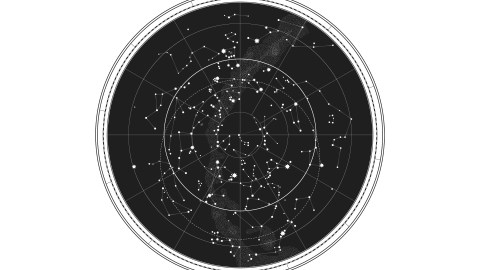Geometries of the Universe: The Math of Knowledge Advancement

This post, by Tom Hartsfield, was originally published in RealClear Science’s Newton blog. You can read the original here.
Back in 8th grade, I hated math. Everyone hated math. Maybe the kid who kept their calculator (or slide rule, for you vintage readers) in a case didn’t hate math. That kid probably became an engineer. Or a physicist. (Confession: I was later the kid with the fancy calculator.) Our rallying cry as math-haters was, “When are we ever going to use this?!” Here’s a wise answer: two basic forms of geometry, learned before high school, are used in almost every engineering project and every physics discovery that has ever been made.
Euclidean Geometry
Greek mathematicians, notably Euclid and Pythagoras (of middle school algebra infamy), laid out the first geometry of the world. They thought of things in terms of shapes made of lines and curves. Their most important discovery was a way to tell how far apart things are:
Take any two places (A and B) and draw a line through each place such that the lines meet (C) at a 90 degree angle. The distance from A to B, squared, is always equal to the distance B-C squared plus the distance from C back to A, squared. (This is the infamous Pythagorean theorem.) This language is perfectly accurate for flat, still surfaces. Notice however, that it only deals in distances between things, not their absolute position. Euclid says “B is five miles north of A” not “B is at 2 Water Lane, Woolsthorpe”.
Cartesian Geometry
Descartes wanted a way to make the points A, B and C refer to absolute things so that anyone anywhere can perform the same measurements. Latin, Chinese, Hebrew and English are all languages of words to catalog or refer to concepts. They are phone books that assign words to ideas. Similarly, the math of Descartes is a phone book, but to assign numbers to places in space. This is called Cartesian geometry. In this language, the Pythagorean Theorem is written like this:
![]()
Where A, B and C are all coordinate numbers, like (0,0) or (-3,5) that you stick into the formula. Euclid would have made you draw lines and geometric shapes and connect them all with theorems!
Descartes’s world is an enormous ream of numbered graph paper. You start with zero somewhere, and then you follow perpendicular lines in all directions. Euclid’s relative distances are replaced by numbers that tell you where you start and where you end and where you are everywhere in between, relative to the entire world. This mathematical machinery is valid for most experiences in day to day life.
Lorentzian Geometry:
Centuries later, Einstein came along and changed everything. His conclusion that the speed of light is constant, and his fitting of experiments to theory demanded a new geometry. In this geometry, objects always move at the speed of light through four-dimensional space-time. The math was invented by Hendrik Lorentz, a brilliant mathematician and physicist of the late 19th century. Lorentzian geometry is much harder to explain, but you can think of the graph paper of Descartes as actually distorted, or squished, like a cardboard carton being smashed:

Cartesian geometry is the black perpendicular lines; Lorentz geometry is the green and red lines. (Source: IEP)
Second, distance rules change a bit, so you have to modify the Pythagorean theorem:
![]()
Where x,y,z,t are the distances you’ve moved in space (x,y,z) and time (t) and c is the speed of light.
Curved spacetime geometry:
After Einstein revolutionized the geometry by which we measure the universe in 1905, he did it again in 1916, when he completed the theory of general relativity. General relativity is so difficult and so complex, that we only know of a few correct answers to its equations. Luckily, however, Einstein realized that the curved universe looks flat if you look at a small enough area of it. This is just like how the earth appears flat to us, standing upon it. Physicists thus work in Lorentz geometry most of the time, and then use the difficult curved geometry to translate between one almost flat “Lorentzian” place and another.
Four increasingly sophisticated geometrical descriptions of the universe, as created by three millennia of human minds. How much deeper will the rabbit hole go?
~
Note: phone book analogy borrowed from “The Phone Book”: Misner Thorne & Wheeler’s Gravitation, a book on general relativity with the authority and heft of a phone book but far greater beauty.





